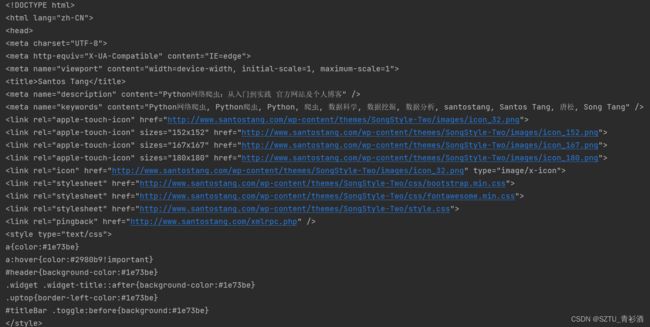- 《Python入门+Python爬虫》——6Day 数据库可视化——Flask框架应用
不摆烂的小劉
pythonpythonflask爬虫
Python学习版本:Python3.X观看:Python入门+Python爬虫+Python数据分析1.Flask入门1.1关于Flask1.1.1了解框架Flask作为Web框架,它的作用主要是为了开发Web应用程序。那么我们首先来了解下Web应用程序。Web应用程序(WorldWideWeb)诞生最初的目的,是为了利用互联网交流工作文档。一切从客户端发起请求开始。所有Flask程序都必须创建
- python爬虫项目(一百九十八):电商平台用户行为数据分析与推荐系统、爬取电商平台用户行为数据
人工智能_SYBH
爬虫试读2025年爬虫百篇实战宝典:从入门到精通python爬虫数据分析开发语言信息可视化okhttp
在现代电商平台中,用户的行为数据对于优化用户体验、提升销量以及个性化推荐至关重要。通过抓取和分析用户的浏览、点击、购买等行为数据,电商平台能够更好地了解用户的偏好,从而推荐相关产品,增加用户的黏性和购买意愿。本篇博客将详细介绍如何通过爬虫技术抓取电商平台的用户行为数据,并结合数据分析和推荐算法,构建一个简单的推荐系统。目录一、电商平台用户行为数据二、爬虫技术实现2.1网站分析2.2使用Seleni
- 爬虫学习第六篇轻松搞定网络请求
笨鸟笃行
python学习爬虫学习python
嘿,小伙伴们!今天咱们来聊聊用Python进行网络请求,这是爬虫学习的敲门砖哦。别怕,跟着我一步步来,保证让你轻松上手!(一)安装requests模块首先,得把requests模块装上。看过上一篇的小伙伴应该都搞定了吧,这玩意儿超好用,能帮我们轻松发起网络请求。如果没搞定的,跟着我重新安装一遍,在vscode的终端里输入pipinstallrequests,回车,搞定!就像给手机装了个APP一样简
- 爬虫学习第一篇(认识爬虫流程和使用工具)
笨鸟笃行
python学习爬虫学习
认识爬虫什么是爬虫?爬虫听着好像是一个什么虫子的名字,其实爬虫是一个自动化请求网站并提取数据的程序,简单理解即是一个自动化爬取数据的脚本例如以下就是一个十分简单的爬虫代码(不过这个代码不适用于所有网页,只能爬取一些没有限制的网站)importrequests#导入请求库url=""#输入爬取内容的地址res=requests.get(url)#发送请求到url这个地址print(res.statu
- 爬虫第二篇(网络通信之发送请求)
笨鸟笃行
python学习爬虫
发起请求请求的组成部分1.请求方式(get,post等)2.请求url(目标的url)3.请求头(一般需要包含user-agent,referer,cookie)4.请求体(主要应用于post请求,post请求的参数在请求体内,get参数一般在url里面)请求方式GET请求1.定义GET请求是HTTP协议中最常见的请求方法之一,用于从服务器获取资源。它通过URL地址来请求数据,通常用于获取网页内容
- Python爬虫实战(一):翻页爬取数据存入SqlServer_python爬虫翻页
2401_84563438
程序员python爬虫sqlserver
print(str(e))#关闭游标,断开数据库cursor.close()db.close()#实现主要逻辑defrun(self):fortype_numinrange(1,46):#1.拼接网页获取每个类别的页数pageurl=self.baseurl%(1,type_num)html_str=self.parse_url(url)page=self.get_page_num(html_st
- 如何使用Python爬虫实时获取股票行情数据并进行分析:完整教程
Python爬虫项目
2025年爬虫实战项目爬虫python开发语言信息可视化c++
前言在金融领域,股票行情的实时获取和分析是投资决策中至关重要的一环。借助Python的强大生态系统,结合爬虫技术和数据分析库,投资者可以实时获取股票行情数据,并通过各种算法和模型进行深入分析。本教程将从零开始,带你深入学习如何使用Python爬取股票行情数据并进行分析。一、爬虫技术概述爬虫是从网络上自动提取信息的程序,它可以帮助我们获取互联网数据。在股票分析中,爬虫技术的应用非常广泛,尤其是通过A
- python爬虫爬取图片
kanguhong
python爬虫开发语言
"""爬取目标:https://pic.netbian.com/彼岸图首页地址:https://pic.netbian.com/4kmeinv/第N页:https://pic.netbian.com/4kmeinv/index_N.htmlhttps://pic.netbian.com/uploads/allimg/240709/194631-1720525591a682.jpg仅供学习,不可用于
- 阿里云服务器的作用
腾云服务器
阿里云服务器云计算
使用阿里云服务器能做什么?大家都知道可以用来搭建网站、数据库、机器学习、Python爬虫、大数据分析等应用,阿里云服务器网来详细说下使用阿里云服务器常见的玩法以及企业或个人用户常见的使用场景:玩转阿里云服务器使用阿里云服务器最常见的应用就是用来搭建网站,例如个人博客、企业网站等;除了搭建网站还可以利用阿里云GPU服务器搭建机器学习和深度学习等AI应用;使用阿里云大数据类型云服务器做数据分析;利用云
- 爬虫获取阿里巴巴 item_search 接口:根据关键字获取在售商品数据
Jelena15779585792
孔夫子API爬虫
在电商领域,快速准确地获取商品信息对于市场分析、选品策略、库存管理以及价格监控等场景至关重要。阿里巴巴开放平台提供的item_search接口允许开发者通过关键字搜索在售商品,并获取相关商品的详细信息。本文将详细介绍如何使用爬虫技术调用item_search接口,获取在售商品数据,并提供完整的开发指南和代码示例。一、接口概述item_search是阿里巴巴开放平台提供的一个API接口,允许开发者通
- Python爬虫获取item_search_img-按图搜索淘宝商品(拍立淘)接口
Jelena15779585792
APIpython爬虫图搜索算法
一、引言随着电商行业的不断发展,消费者对商品搜索的效率和准确性要求越来越高。淘宝作为国内领先的电商平台,推出了按图搜索商品的功能(拍立淘),极大地提升了用户的购物体验。本文将详细介绍如何使用淘宝按图搜索商品的API接口(item_search_img),包括注册账号、上传图片、调用接口及解析响应等步骤。二、注册账号与获取API密钥注册淘宝开放平台账号要使用淘宝的按图搜索功能,首先需要在淘宝开放平台
- 使用Python爬虫获取淘宝搜索词推荐API接口
Jelena15779585792
淘宝APIPythonpython爬虫开发语言
在电商领域,搜索词推荐功能对于优化用户体验和提升搜索效率至关重要。淘宝作为国内领先的电商平台,提供了丰富的API接口,其中item_search_suggest接口可以获取搜索词推荐。本文将详细介绍如何使用Python爬虫技术调用该API接口,并获取搜索词推荐信息。一、概述淘宝的item_search_suggestAPI接口允许开发者根据提供的搜索关键字或其他相关条件,返回与搜索词相关的推荐词组
- 使用 Python 爬虫抓取电商平台特定商品库存与销售数据的完整指南
Python爬虫项目
2025年爬虫实战项目python爬虫开发语言信息可视化自动化
一、引言随着电子商务的蓬勃发展,库存和销售数据已经成为商家、供应链管理者和市场分析师的重要参考。对于电商平台而言,实时获取商品库存、销量以及价格等信息,能够帮助商家及时调整策略、优化存货管理、做出销售预测。因此,抓取这些电商平台上的商品数据变得至关重要。本文将详细介绍如何使用Python编写爬虫,抓取电商平台(如淘宝、京东、亚马逊等)上特定商品的库存、销售数据。我们将结合最新技术,使用Reques
- 使用Python爬虫抓取并分析电商网站销量数据的完整指南
Python爬虫项目
2025年爬虫实战项目python爬虫开发语言selenium
目录:前言爬虫基础概念什么是Web爬虫爬虫的工作原理Python爬虫库介绍准备工作安装所需的库选择目标电商网站分析目标电商网站使用浏览器开发者工具分析页面结构识别需要抓取的销量数据构建爬虫程序使用requests获取网页使用BeautifulSoup解析静态网页使用Selenium抓取动态页面防止反爬虫技术模拟浏览器请求使用代理池随机延迟请求抓取电商网站的销量数据抓取商品标题、销量、价格等信息处理
- 【Python爬虫(67)】Python爬虫实战:探秘旅游网站数据宝藏
奔跑吧邓邓子
Python爬虫python爬虫开发语言旅游网站
【Python爬虫】专栏简介:本专栏是Python爬虫领域的集大成之作,共100章节。从Python基础语法、爬虫入门知识讲起,深入探讨反爬虫、多线程、分布式等进阶技术。以大量实例为支撑,覆盖网页、图片、音频等各类数据爬取,还涉及数据处理与分析。无论是新手小白还是进阶开发者,都能从中汲取知识,助力掌握爬虫核心技能,开拓技术视野。目录一、引言二、爬虫前期准备2.1目标网站分析2.2技术栈选择2.3环
- 【Python爬虫(81)】当量子计算邂逅Python爬虫:一场技术变革的预演
奔跑吧邓邓子
Python爬虫量子计算python爬虫开发语言
【Python爬虫】专栏简介:本专栏是Python爬虫领域的集大成之作,共100章节。从Python基础语法、爬虫入门知识讲起,深入探讨反爬虫、多线程、分布式等进阶技术。以大量实例为支撑,覆盖网页、图片、音频等各类数据爬取,还涉及数据处理与分析。无论是新手小白还是进阶开发者,都能从中汲取知识,助力掌握爬虫核心技能,开拓技术视野。目录一、量子计算:崭露头角的技术新星1.1量子计算的基本原理1.2发展
- 【Python爬虫(100)】从当下到未来:Python爬虫技术的进阶之路
奔跑吧邓邓子
Python爬虫python爬虫开发语言未来发展
【Python爬虫】专栏简介:本专栏是Python爬虫领域的集大成之作,共100章节。从Python基础语法、爬虫入门知识讲起,深入探讨反爬虫、多线程、分布式等进阶技术。以大量实例为支撑,覆盖网页、图片、音频等各类数据爬取,还涉及数据处理与分析。无论是新手小白还是进阶开发者,都能从中汲取知识,助力掌握爬虫核心技能,开拓技术视野。目录一、爬虫技术发展现状与瓶颈1.1爬虫技术发展现状1.2爬虫技术瓶颈
- 【Python爬虫(88)】当Python爬虫邂逅智能硬件:解锁数据新玩法
奔跑吧邓邓子
Python爬虫python爬虫智能硬件开发语言
【Python爬虫】专栏简介:本专栏是Python爬虫领域的集大成之作,共100章节。从Python基础语法、爬虫入门知识讲起,深入探讨反爬虫、多线程、分布式等进阶技术。以大量实例为支撑,覆盖网页、图片、音频等各类数据爬取,还涉及数据处理与分析。无论是新手小白还是进阶开发者,都能从中汲取知识,助力掌握爬虫核心技能,开拓技术视野。目录一、引言二、智能硬件的数据采集需求剖析2.1智能音箱的数据采集需求
- 【Python爬虫(98)】从数据抓取到产业变革:爬虫技术的跨界融合与生态进化
奔跑吧邓邓子
Python爬虫python爬虫开发语言产业融合生态
【Python爬虫】专栏简介:本专栏是Python爬虫领域的集大成之作,共100章节。从Python基础语法、爬虫入门知识讲起,深入探讨反爬虫、多线程、分布式等进阶技术。以大量实例为支撑,覆盖网页、图片、音频等各类数据爬取,还涉及数据处理与分析。无论是新手小白还是进阶开发者,都能从中汲取知识,助力掌握爬虫核心技能,开拓技术视野。目录一、引言二、爬虫技术在新兴产业中的深度融合2.1智能医疗领域的应用
- 【数据分析】4 商业数据分析技能模型总结
loyd3
数据分析数据分析数据挖掘
优秀的商业分析师需要具备的能力数据分析能力逻辑思维能力赢得结果能力一、数据分析能力扩展:工具链生态与进阶场景1.数据获取技术升级企业级数据源管理:数据湖架构(AWSS3/阿里云OSS)与数据仓库(Snowflake/Redshift)权限管理API自动化采集(Postman+PythonRequests模块)反爬虫策略突破(IP代理池/Selenium模拟登录)新兴数据源拓展:社交舆情数据(Twi
- Python 网络爬虫入门全知道
安年CJ
Pythonpython爬虫开发语言运维php服务器
一、引言在当今数字化时代,网络上的数据量呈爆炸式增长。无论是进行数据分析、市场调研,还是开发智能应用,获取网络数据都变得极为重要。而Python网络爬虫就是一把打开网络数据宝库的利器。它能够自动地从网页中抓取我们需要的信息,为后续的数据处理和分析提供丰富的素材。本博客将带领大家逐步走进Python网络爬虫的精彩世界。二、网络爬虫基础概念(一)什么是网络爬虫网络爬虫,也称为网页蜘蛛,是一种按照一定的
- 【2025年07期免费获取股票数据API接口】实例演示五种主流语言获取股票行情api接口之沪深A股历史分时KDJ数据获取实例演示及接口API说明文档
不会写代码的码农农
pythonjava开发语言大数据
在近一至两年期间,股票量化分析逐步成为备受关注的热门议题。对于投身于该领域工作而言,首要步骤便是获取全面且精准的股票数据。无论是实时交易数据、历史交易记录、财务数据,亦或是基本面信息,这些数据均是开展量化分析过程中不可或缺的宝贵资源。我们的核心任务在于从这些数据中提炼出具有价值的信息,从而为投资策略提供坚实有力的指导。在数据探索进程中,我尝试运用了多种方法,涵盖自编网易股票页面爬虫程序、申万行业数
- Python网络安全脚本
网络安全Ash
pythonweb安全开发语言
点击文末小卡片,免费获取网络安全全套资料,资料在手,涨薪更快前言睡不着,那就起来学习其实base64模块很早之前用过今天做爬虫的时候有个URL需要用它来编码一下所以百度又学了一下遇到最大的问题就是python3和python2区别问题python3的这个不支持直接上字符串纠结了好久。base64编码Base64是网络上最常见的用于传输8Bit字节代码的编码方式之一,大家可以查看RFC2045~RF
- 爬虫必备html和css基础知识
ylfhpy
爬虫项目入门爬虫htmlcsspython
一、引言在当今数字化时代,网络上蕴含着海量的有价值数据。Python爬虫技术凭借其高效、灵活的特点,成为了获取这些数据的重要手段。而网页数据通常以HTML格式呈现,要想准确地从网页中提取所需信息,就需要深入了解HTML标签的结构和含义,以及如何运用CSS选择器精准定位目标元素。本文将围绕这两方面展开详细阐述,旨在帮助掌握Python爬虫的关键基础技能。二、常用HTML标签详解2.1文本结构标签2.
- 2020年Python最新面试题(四):爬虫基础知识
Amo Xiang
Python3入门与进阶pythonhttp面试题spider
目录1.什么是爬虫?2.爬虫的基本流程有哪些?3.Request中包含了哪些内容?4.Response中包含了哪些内容5.HTTP请求中的POST、GET有什么区别?6.HTTP、HTTPS协议有什么区别?7.Cookie和Session有什么区别?8.域名和IP之间有什么关系?如何查看某个域名对应的IP地址?9.在HTTP协议头中,keep-alive字段有什么作用?10.HTTP常用的状态码(
- Python并发编程实战:用concurrent.futures榨干CPU性能的终极指南
清水白石008
pythonPython题库python网络服务器
Python并发编程实战:用concurrent.futures榨干CPU性能的终极指南引言:从“单线程苦力”到“并发指挥官”你是否遇到过这样的场景?处理10万条数据需要跑通宵,Web爬虫每秒只能请求3次,批量处理图片时CPU利用率不到20%……这些问题的根源往往在于未能有效利用计算资源。Python的concurrent.futures模块提供了一种优雅的解决方案——通过线程池和进程池,开发者可
- python 基于aiohttp的异步爬虫实战
钢铁知识库
python教程python爬虫开发语言
钢铁知识库,一个学习python爬虫、数据分析的知识库。人生苦短,快用python。之前我们使用requests库爬取某个站点的时候,每发出一个请求,程序必须等待网站返回响应才能接着运行,而在整个爬虫过程中,整个爬虫程序是一直在等待的,实际上没有做任何事情。像这种占用磁盘/内存IO、网络IO的任务,大部分时间是CPU在等待的操作,就叫IO密集型任务。对于这种情况有没有优化方案呢,当然有,那就是使用
- 100天精通Python(爬虫篇)——第113天:爬虫基础模块之urllib详细教程大全
m0_74825074
面试学习路线阿里巴巴python爬虫开发语言
文章目录1.urllib概述2.urllib.request模块1.urllib.request.urlopen()2.urllib.request.urlretrieve()3.urllib.request.Request()4.urllib.request.install_opener()5.urllib.request.build_opener()6.urllib.request.Abstr
- aiohttp的详细使用和异步爬虫实战
数据知道
2025年爬虫和逆向教程爬虫pythonaiohttpasyncio异步爬虫
文章目录1.基本概念2.安装aiohttp3.一个简单的异步爬虫4.示例代码及解析5.并发控制6.错误处理7.数据解析与存储8.高级用法8.1限速8.2处理JavaScript渲染的页面8.3异步文件写入8.4POST请求8.5使用代理8.6超时设置9.总结aiohttp是一个基于asyncio的异步HTTP客户端/服务器框架,非常适合用于编写高效的异步爬虫。下面我们将详细讲解如何使用aiohtt
- python模拟app操作_Python爬虫入门教程 49-100 Appium安装+操作51JOB_APP(模拟手机操作之一)手机APP爬虫-阿里云开发者社区...
weixin_39892019
python模拟app操作
爬前准备工作在开始安装Appium之前,你要先知道Appium是做什么的?Appium是一个自动化测试开源工具,看到没,做测试用的,它有点类似Selenium,可以自动操作APP实现一系列的操作。标记重点,可以使用python对Appium编写脚本,实现对App的抓取。今天就给你写一个100%叫你可以运行起来的入门实例。下载地址下载之后,双击exe安装即可出现如下界面,表示安装成功,先不要进行其他
- 枚举的构造函数中抛出异常会怎样
bylijinnan
javaenum单例
首先从使用enum实现单例说起。
为什么要用enum来实现单例?
这篇文章(
http://javarevisited.blogspot.sg/2012/07/why-enum-singleton-are-better-in-java.html)阐述了三个理由:
1.enum单例简单、容易,只需几行代码:
public enum Singleton {
INSTANCE;
- CMake 教程
aigo
C++
转自:http://xiang.lf.blog.163.com/blog/static/127733322201481114456136/
CMake是一个跨平台的程序构建工具,比如起自己编写Makefile方便很多。
介绍:http://baike.baidu.com/view/1126160.htm
本文件不介绍CMake的基本语法,下面是篇不错的入门教程:
http:
- cvc-complex-type.2.3: Element 'beans' cannot have character
Cb123456
springWebgis
cvc-complex-type.2.3: Element 'beans' cannot have character
Line 33 in XML document from ServletContext resource [/WEB-INF/backend-servlet.xml] is i
- jquery实例:随页面滚动条滚动而自动加载内容
120153216
jquery
<script language="javascript">
$(function (){
var i = 4;$(window).bind("scroll", function (event){
//滚动条到网页头部的 高度,兼容ie,ff,chrome
var top = document.documentElement.s
- 将数据库中的数据转换成dbs文件
何必如此
sqldbs
旗正规则引擎通过数据库配置器(DataBuilder)来管理数据库,无论是Oracle,还是其他主流的数据都支持,操作方式是一样的。旗正规则引擎的数据库配置器是用于编辑数据库结构信息以及管理数据库表数据,并且可以执行SQL 语句,主要功能如下。
1)数据库生成表结构信息:
主要生成数据库配置文件(.conf文
- 在IBATIS中配置SQL语句的IN方式
357029540
ibatis
在使用IBATIS进行SQL语句配置查询时,我们一定会遇到通过IN查询的地方,在使用IN查询时我们可以有两种方式进行配置参数:String和List。具体使用方式如下:
1.String:定义一个String的参数userIds,把这个参数传入IBATIS的sql配置文件,sql语句就可以这样写:
<select id="getForms" param
- Spring3 MVC 笔记(一)
7454103
springmvcbeanRESTJSF
自从 MVC 这个概念提出来之后 struts1.X struts2.X jsf 。。。。。
这个view 层的技术一个接一个! 都用过!不敢说哪个绝对的强悍!
要看业务,和整体的设计!
最近公司要求开发个新系统!
- Timer与Spring Quartz 定时执行程序
darkranger
springbean工作quartz
有时候需要定时触发某一项任务。其实在jdk1.3,java sdk就通过java.util.Timer提供相应的功能。一个简单的例子说明如何使用,很简单: 1、第一步,我们需要建立一项任务,我们的任务需要继承java.util.TimerTask package com.test; import java.text.SimpleDateFormat; import java.util.Date;
- 大端小端转换,le32_to_cpu 和cpu_to_le32
aijuans
C语言相关
大端小端转换,le32_to_cpu 和cpu_to_le32 字节序
http://oss.org.cn/kernel-book/ldd3/ch11s04.html
小心不要假设字节序. PC 存储多字节值是低字节为先(小端为先, 因此是小端), 一些高级的平台以另一种方式(大端)
- Nginx负载均衡配置实例详解
avords
[导读] 负载均衡是我们大流量网站要做的一个东西,下面我来给大家介绍在Nginx服务器上进行负载均衡配置方法,希望对有需要的同学有所帮助哦。负载均衡先来简单了解一下什么是负载均衡,单从字面上的意思来理解就可以解 负载均衡是我们大流量网站要做的一个东西,下面我来给大家介绍在Nginx服务器上进行负载均衡配置方法,希望对有需要的同学有所帮助哦。
负载均衡
先来简单了解一下什么是负载均衡
- 乱说的
houxinyou
框架敏捷开发软件测试
从很久以前,大家就研究框架,开发方法,软件工程,好多!反正我是搞不明白!
这两天看好多人研究敏捷模型,瀑布模型!也没太搞明白.
不过感觉和程序开发语言差不多,
瀑布就是顺序,敏捷就是循环.
瀑布就是需求、分析、设计、编码、测试一步一步走下来。而敏捷就是按摸块或者说迭代做个循环,第个循环中也一样是需求、分析、设计、编码、测试一步一步走下来。
也可以把软件开发理
- 欣赏的价值——一个小故事
bijian1013
有效辅导欣赏欣赏的价值
第一次参加家长会,幼儿园的老师说:"您的儿子有多动症,在板凳上连三分钟都坐不了,你最好带他去医院看一看。" 回家的路上,儿子问她老师都说了些什么,她鼻子一酸,差点流下泪来。因为全班30位小朋友,惟有他表现最差;惟有对他,老师表现出不屑,然而她还在告诉她的儿子:"老师表扬你了,说宝宝原来在板凳上坐不了一分钟,现在能坐三分钟。其他妈妈都非常羡慕妈妈,因为全班只有宝宝
- 包冲突问题的解决方法
bingyingao
eclipsemavenexclusions包冲突
包冲突是开发过程中很常见的问题:
其表现有:
1.明明在eclipse中能够索引到某个类,运行时却报出找不到类。
2.明明在eclipse中能够索引到某个类的方法,运行时却报出找不到方法。
3.类及方法都有,以正确编译成了.class文件,在本机跑的好好的,发到测试或者正式环境就
抛如下异常:
java.lang.NoClassDefFoundError: Could not in
- 【Spark七十五】Spark Streaming整合Flume-NG三之接入log4j
bit1129
Stream
先来一段废话:
实际工作中,业务系统的日志基本上是使用Log4j写入到日志文件中的,问题的关键之处在于业务日志的格式混乱,这给对日志文件中的日志进行统计分析带来了极大的困难,或者说,基本上无法进行分析,每个人写日志的习惯不同,导致日志行的格式五花八门,最后只能通过grep来查找特定的关键词缩小范围,但是在集群环境下,每个机器去grep一遍,分析一遍,这个效率如何可想之二,大好光阴都浪费在这上面了
- sudoku solver in Haskell
bookjovi
sudokuhaskell
这几天没太多的事做,想着用函数式语言来写点实用的程序,像fib和prime之类的就不想提了(就一行代码的事),写什么程序呢?在网上闲逛时发现sudoku游戏,sudoku十几年前就知道了,学生生涯时也想过用C/Java来实现个智能求解,但到最后往往没写成,主要是用C/Java写的话会很麻烦。
现在写程序,本人总是有一种思维惯性,总是想把程序写的更紧凑,更精致,代码行数最少,所以现
- java apache ftpClient
bro_feng
java
最近使用apache的ftpclient插件实现ftp下载,遇见几个问题,做如下总结。
1. 上传阻塞,一连串的上传,其中一个就阻塞了,或是用storeFile上传时返回false。查了点资料,说是FTP有主动模式和被动模式。将传出模式修改为被动模式ftp.enterLocalPassiveMode();然后就好了。
看了网上相关介绍,对主动模式和被动模式区别还是比较的模糊,不太了解被动模
- 读《研磨设计模式》-代码笔记-工厂方法模式
bylijinnan
java设计模式
声明: 本文只为方便我个人查阅和理解,详细的分析以及源代码请移步 原作者的博客http://chjavach.iteye.com/
package design.pattern;
/*
* 工厂方法模式:使一个类的实例化延迟到子类
* 某次,我在工作不知不觉中就用到了工厂方法模式(称为模板方法模式更恰当。2012-10-29):
* 有很多不同的产品,它
- 面试记录语
chenyu19891124
招聘
或许真的在一个平台上成长成什么样,都必须靠自己去努力。有了好的平台让自己展示,就该好好努力。今天是自己单独一次去面试别人,感觉有点小紧张,说话有点打结。在面试完后写面试情况表,下笔真的好难,尤其是要对面试人的情况说明真的好难。
今天面试的是自己同事的同事,现在的这个同事要离职了,介绍了我现在这位同事以前的同事来面试。今天这位求职者面试的是配置管理,期初看了简历觉得应该很适合做配置管理,但是今天面
- Fire Workflow 1.0正式版终于发布了
comsci
工作workflowGoogle
Fire Workflow 是国内另外一款开源工作流,作者是著名的非也同志,哈哈....
官方网站是 http://www.fireflow.org
经过大家努力,Fire Workflow 1.0正式版终于发布了
正式版主要变化:
1、增加IWorkItem.jumpToEx(...)方法,取消了当前环节和目标环节必须在同一条执行线的限制,使得自由流更加自由
2、增加IT
- Python向脚本传参
daizj
python脚本传参
如果想对python脚本传参数,python中对应的argc, argv(c语言的命令行参数)是什么呢?
需要模块:sys
参数个数:len(sys.argv)
脚本名: sys.argv[0]
参数1: sys.argv[1]
参数2: sys.argv[
- 管理用户分组的命令gpasswd
dongwei_6688
passwd
NAME: gpasswd - administer the /etc/group file
SYNOPSIS:
gpasswd group
gpasswd -a user group
gpasswd -d user group
gpasswd -R group
gpasswd -r group
gpasswd [-A user,...] [-M user,...] g
- 郝斌老师数据结构课程笔记
dcj3sjt126com
数据结构与算法
<<<<<<<<<<<<<<<<<<<<<<<<<<<<<<<<<<<<<<<<<<<<<<<<<<
- yii2 cgridview加上选择框进行操作
dcj3sjt126com
GridView
页面代码
<?=Html::beginForm(['controller/bulk'],'post');?>
<?=Html::dropDownList('action','',[''=>'Mark selected as: ','c'=>'Confirmed','nc'=>'No Confirmed'],['class'=>'dropdown',])
- linux mysql
fypop
linux
enquiry mysql version in centos linux
yum list installed | grep mysql
yum -y remove mysql-libs.x86_64
enquiry mysql version in yum repositoryyum list | grep mysql oryum -y list mysql*
install mysq
- Scramble String
hcx2013
String
Given a string s1, we may represent it as a binary tree by partitioning it to two non-empty substrings recursively.
Below is one possible representation of s1 = "great":
- 跟我学Shiro目录贴
jinnianshilongnian
跟我学shiro
历经三个月左右时间,《跟我学Shiro》系列教程已经完结,暂时没有需要补充的内容,因此生成PDF版供大家下载。最近项目比较紧,没有时间解答一些疑问,暂时无法回复一些问题,很抱歉,不过可以加群(334194438/348194195)一起讨论问题。
----广告-----------------------------------------------------
- nginx日志切割并使用flume-ng收集日志
liyonghui160com
nginx的日志文件没有rotate功能。如果你不处理,日志文件将变得越来越大,还好我们可以写一个nginx日志切割脚本来自动切割日志文件。第一步就是重命名日志文件,不用担心重命名后nginx找不到日志文件而丢失日志。在你未重新打开原名字的日志文件前,nginx还是会向你重命名的文件写日志,linux是靠文件描述符而不是文件名定位文件。第二步向nginx主
- Oracle死锁解决方法
pda158
oracle
select p.spid,c.object_name,b.session_id,b.oracle_username,b.os_user_name from v$process p,v$session a, v$locked_object b,all_objects c where p.addr=a.paddr and a.process=b.process and c.object_id=b.
- java之List排序
shiguanghui
list排序
在Java Collection Framework中定义的List实现有Vector,ArrayList和LinkedList。这些集合提供了对对象组的索引访问。他们提供了元素的添加与删除支持。然而,它们并没有内置的元素排序支持。 你能够使用java.util.Collections类中的sort()方法对List元素进行排序。你既可以给方法传递
- servlet单例多线程
utopialxw
单例多线程servlet
转自http://www.cnblogs.com/yjhrem/articles/3160864.html
和 http://blog.chinaunix.net/uid-7374279-id-3687149.html
Servlet 单例多线程
Servlet如何处理多个请求访问?Servlet容器默认是采用单实例多线程的方式处理多个请求的:1.当web服务器启动的

